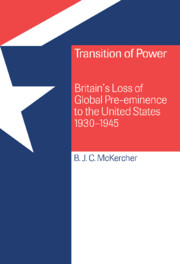Book contents
- Frontmatter
- Contents
- Acknowledgments
- List of abbreviations
- Prologue: Power and purpose in Anglo-American relations, 1919–1929
- 1 The end of Anglo-American naval rivalry, 1929–1930
- 2 The undermining of war debts and reparations, 1929–1932
- 3 Disarmament and security in Europe and the Far East, 1930–1932
- 4 The unravelling of co-operation, 1932–1933
- 5 Moving away from the United States, 1933–1934
- 6 Britain, the United States, and the global balance of power, 1934–1935
- 7 From Abyssinia to Brussels via London, Madrid, and Peking, 1935–1937
- 8 Appeasement, deterrence, and Anglo-American relations, 1938–1939
- 9 Belligerent Britain and the neutral United States, 1939–1941
- Epilogue: ‘A new order of things’, 1941–1945
- Select Bibliography
- Index
3 - Disarmament and security in Europe and the Far East, 1930–1932
Published online by Cambridge University Press: 15 July 2009
- Frontmatter
- Contents
- Acknowledgments
- List of abbreviations
- Prologue: Power and purpose in Anglo-American relations, 1919–1929
- 1 The end of Anglo-American naval rivalry, 1929–1930
- 2 The undermining of war debts and reparations, 1929–1932
- 3 Disarmament and security in Europe and the Far East, 1930–1932
- 4 The unravelling of co-operation, 1932–1933
- 5 Moving away from the United States, 1933–1934
- 6 Britain, the United States, and the global balance of power, 1934–1935
- 7 From Abyssinia to Brussels via London, Madrid, and Peking, 1935–1937
- 8 Appeasement, deterrence, and Anglo-American relations, 1938–1939
- 9 Belligerent Britain and the neutral United States, 1939–1941
- Epilogue: ‘A new order of things’, 1941–1945
- Select Bibliography
- Index
Summary
I asked the United States Ambassador to come and see me this morning in order that I might speak to him about the question of arrangements for the World Disarmament Conference … my greatest hopes were based on co-operation with the United States Government, who, with His Majesty's Government, might exercise a decisive influence at the conference.
Henderson, February 1931Since first meeting in 1926, the Preparatory Commission had made little progress because of the dichotomy between arms limitation and national security. Here lay the root of the different emphases of the British and French draft treaties and the British and American divergence over cruisers. The French and their allies wanted to preserve the security system that had emerged at Locarno, one having at its core their unrestricted land-based military strength and the limited size and nature of the German armed forces. The British sought to balance France and Germany on the Continent and safeguard the naval equilibrium achieved at the Washington conference. The naval treaty allowed the RN a strategic advantage in European and Mediterranean waters and, with the four- and nine-Power treaties, looked to maintain the status quo in the western Pacific Ocean and China. Though supporting the tenor of the British draft treaty – for instance, limiting tonnage by class rather than by a universal total for each Power – Washington and Tokyo pursued modifications to meet their particular security requirements: the USN's desire for a large number of heavy cruisers and the IJN's resolve to increase its cruiser tonnage ratio. Preparatory Commission discussions went into abeyance after April 1929, when Gibson announced the ‘yardstick’. Whilst the obstacles to reconciling the competing French and British draft treaties still lurked in the background, Anglo-American naval differences constituted the immediate block to progress.
- Type
- Chapter
- Information
- Transition of PowerBritain's Loss of Global Pre-eminence to the United States, 1930–1945, pp. 95 - 125Publisher: Cambridge University PressPrint publication year: 1999

